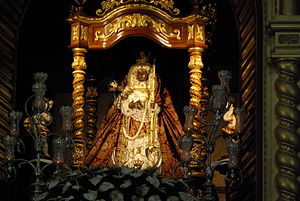Virgin of Candelaria
Virgin of Candelaria | |
|---|---|
 | |
| Venerated in | Roman Catholic Church |
| Major shrine | Basílica de Nuestra Señora de la Candelaria, Tenerife |
| Feast | August 14-15 (on Tenerife)[1] |
| Attributes | dark skin; baby in her right hand and a candle in her left hand |
| Patronage | Canary Islands as well as Tenerife; Medellín (Colombia), Puno (Peru), and Mayagüez (Puerto Rico) |
The cult of the Virgin of Candelaria or Our Lady of Candelaria (Virgen de Candelaria, Nuestra Señora de la Candelaria), popularly called La Morenita, celebrates an apparition of the Virgin Mary on the island of Tenerife, one of the Canary Islands. The center of her cult is at Candelaria, Tenerife. She is depicted as a Black Madonna. She is the Mistress of Canary Isles.
Legend
According to a legend recorded by Alonso de Espinosa in 1594, a statue of the Virgin Mary, bearing a child in one hand and a green candle in the other (hence "Candelaria"), was discovered on the beach of Chimisay (Güímar) by two Guanche goatherds in 1392.[2] This occurred before the Castilian conquest of the island (the island was not fully conquered until 1496).
One of the shepherds tried to throw a stone at the statue, but his arm became paralyzed; the other tried to stab the statue with a knife but ended up stabbing himself.[3][2] The statue was taken by the local Guanche mencey, Acaymo, to the cave of Chinguaro. However, the statue was stolen and taken away to Lanzarote. It was brought back after the statue caused various events to occur on Lanzarote.[2]
Later, the statue, now returned to Tenerife, was recognized by Antón, a Guanche who had been enslaved and converted to Christianity by the Castilians, as the Virgin Mary when he returned to Tenerife. He told the mencey of his conversion and the statue was thus venerated by the Guanches, who translated the statue to the cave of Achbinico (also known as San Blas -"Saint Blaise").[3]
Veneration

The first mass was celebrated at Achbinico on February 2, 1497, and the Adelantado Alonso Fernández de Lugo ordered the construction of a hermitage there, but it was not built until 1526, during the rule of Pedro Fernández de Lugo.[4] This was the site of the Basilica of Our Lady of Candelaria.[2] The basilica was destroyed by fire and rebuilt in the 19th century.[2] The statue itself was lost when a tidal wave carried it out to sea in 1826; the present statue is a copy by Fernando Estévez.[2]
She was declared patroness of the Canary Islands in 1559, by Clement VIII (and principal patroness in 1867).[3]
She is widely venerated in South America, where she is the patroness of Medellín (Colombia), Puno (Peru), and Mayagüez (Puerto Rico) (which was founded as Nuestra Señora de la Candelaria de Mayagüez). There is an image of her at San Antonio, Texas, center of an isleño community, as well. In the Caribbean African diaspora religion Santería, the Virgin of Candelaria was syncretised with the goddess Iansan.
-
Basílica de Nuestra Señora de la Candelaria
-
Basílica de Nuestra Señora de la Candelaria, Virgen de la Candelaria
-
Basílica de Nuestra Señora de la Candelaria
-
Basílica de Nuestra Señora de la Candelaria




